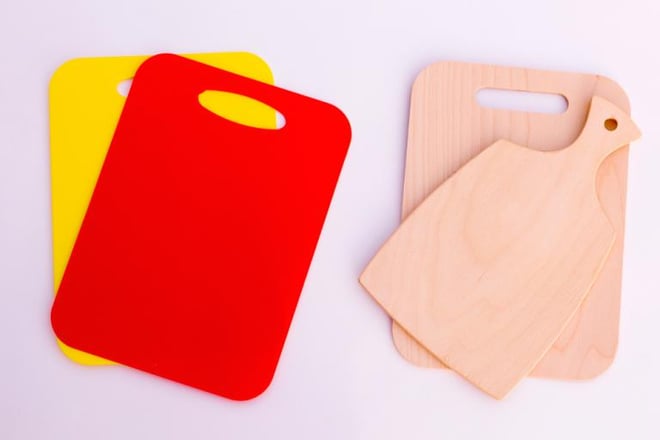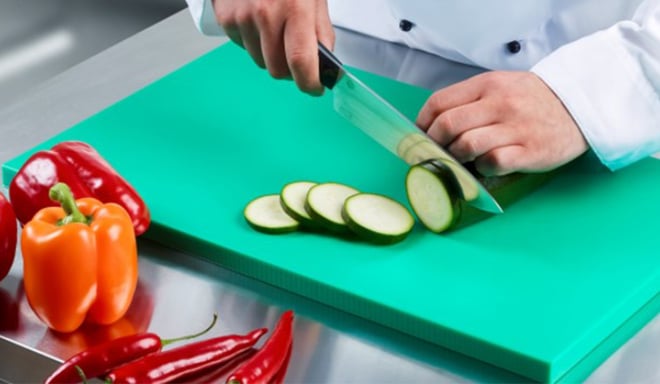Cutting boards are indispensable tools in any kitchen. Their main function is to provide a flat and stable surface to make cuts safely and protect the tables and extend the life of the knife edges.
Wooden or plastic cutting boards?
At present, it is expected that one of the questions that we ask ourselves when purchasing a table is about the material. We can find them in different colors, thicknesses, materials, etc., and the most common are made from wood or plastic. On this occasion, we will not answer this question based on design or comfort, but on resistance, durability, and above all, based on hygiene.

In the food industry (butchers, restaurants, etc.), wooden boards are prohibited because they are porous and absorbent, encouraging them to retain germs. In addition, they absorb moisture from food and water when washing them, which causes the appearance of fungi. On the other hand, plastic boards do not have a porous surface, so they are less likely to develop fungi or bacteria; they are also lighter and easier to handle.
Characteristics of a good cutting board:
For the selection of a good cutting board for food, we must take into account important things such as:
- Stability: It has to be a table that does not move when you are making the cuts.
- Easy cleaning: Choose a table that has an easy-to-clean surface.
- Size: It is essential that the table is handled well and adapts perfectly to the size of the food you are cutting.
- Safety: Verify that the material has approvals for work in contact with food.
Rochling® has the most extensive line of food contact materials. Polystone® Cut-Rite is a high-density polyethylene sheet designed for cutting commercial and consumer foods. A textured matte finish on both sides prevents the knife from slipping and dulling.
Why use Cut-Rite plates for food cutting?
- When choosing a material for a cutting board or work table, the quality of the material must be taken into account since there are from the very basic ones, cheap but that are easily damaged, so it is better to invest in a recognized brand that offers long-term guarantees. term.
- It should be emphasized that poor quality in the material of the food cutting plates can cause premature wear of the same, detaching particles of the material in the food that can go to human consumption with the harmful effects that this suggests.
- The boards for cutting food manufactured in high-density polyethylene (HDPE) with a rough finish have been determined as the perfect configuration for this purpose since they provide as their main function a flat and stable surface on which to make a shape cut. safe, and the rough finish helps us protect and extend the life of the edges of our knives.
- The high-quality plastic boards are easily washed and sanitized and can even go into the dishwasher. As they are manufactured in HDPE, the material has excellent resistance to chemical attacks from the products used to disinfect the plates, which allows them to be washed at the request or taste of the user.
- In terms of maintenance, HDPE cutting boards can be a good ally, although it is true that wooden boards can have a better aesthetic finish, they are usually more difficult to disinfect than plastic boards, this means in the first instance, that the use of wooden planks could increase the risk of foodborne illness or food poisoning. At present, the FDA in the USA determined the illegality of using wooden boards to cut food in restaurants or any food service, due to the impossibility of guaranteeing its safety.
- But bacteria are not the only problem. There is another less serious but also harmful type of pollution: that of odors. If products with a very strong aroma are cut on the board, such as fish and then the same is done with fruits or cheeses, it is possible that the smell of the former permeates the latter, as a result, the product is less enjoyed and even, it can generate displeasure.

Among the products offered by LDM®, you can find the Cut-Rite plate, which is an HDPE plate with a rough finish, ideal for applying it as a food cutting board for high-performance use, which also has FDA approval. and the USDA for work in contact with food, which you can acquire in measures of 1/4 ", 1/2", 3/4 "and 1" thick, depending on the time of life and the use that is made. intends to give, in addition, there is the possibility of manufacturing it in specific colors on request.
Do not wait more! Download the brochure and learn more about this amazing product.
Do not wait more! Download the brochure and learn more about this amazing product.

